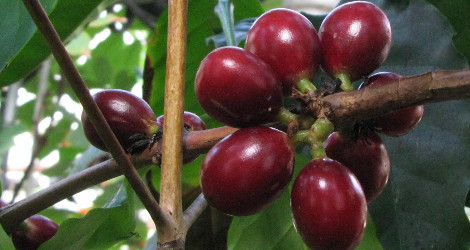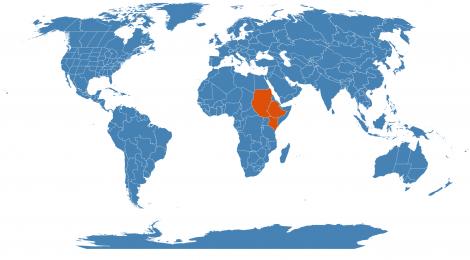Accession Data:
Coffea arabica L.
- Common Name: Arabica Coffee
- Family: Rubiaceae Juss.
- Description: A relative of the gardenia and Ixora, it is an attractive shrub with glossy evergreen leaves. It prefers light shade, is hardy to 28°F and can be used as a potted specimen, though some varieties grow into large trees. The flowers are white, star-like, fragrant, in axillary clusters which appear in the spring. The fruit are red when ripe, in the fall, with a sweet pulp surrounding the bean.
- Uses: The cherries of this plant contain seeds commonly known as coffee beans that are used to make the hot beverage coffee. Coffee contains the chemical caffeine which is used to alleviate fatigue. It also increases the pain relieving effects of aspirin and acetaminophen by constricting the blood vessels that when dilated cause headaches. However, caffeine is very addictive.
- USDA Zone: 10a-11
Accession Data:
- Accession # 198500493
- Source: Stock
- Recorded Vouchers:
- Voucher 129182 at George Safford Torrey Herbarium (CONN). Specimen collected 10 February 2005. Herbarium Image
- Accession Date: 12-31-1985
- Bench: 1109 - AFR:Ground Bed 1 SW
- Currently: active - healthy
- Qty: 1 confirmed on 02-26-2025
Classification:
- Division: Magnoliophyta
- Class: Magnoliopsida
- SubClass: euasterid I
- Order: Gentianales
- SubOrder:
- Family: Rubiaceae
- SubFamily: Ixoroideae
- Tribe: Coffeeae
- SubTribe:
Flowering Data:
This accession has been observed in bloom on:| Year | Jan | Feb | Mar | Apr | May | Jun | Jul | Aug | Sep | Oct | Nov | Dec | ||||||||||||||||||||||||||||||||||||||||
|---|---|---|---|---|---|---|---|---|---|---|---|---|---|---|---|---|---|---|---|---|---|---|---|---|---|---|---|---|---|---|---|---|---|---|---|---|---|---|---|---|---|---|---|---|---|---|---|---|---|---|---|---|
| 2025 | ||||||||||||||||||||||||||||||||||||||||||||||||||||
| 2024 | ||||||||||||||||||||||||||||||||||||||||||||||||||||
| 2023 | ||||||||||||||||||||||||||||||||||||||||||||||||||||
| 2022 | ||||||||||||||||||||||||||||||||||||||||||||||||||||
| 2021 | ||||||||||||||||||||||||||||||||||||||||||||||||||||
| 2020 | ||||||||||||||||||||||||||||||||||||||||||||||||||||
| 2019 | ||||||||||||||||||||||||||||||||||||||||||||||||||||
| 2018 | ||||||||||||||||||||||||||||||||||||||||||||||||||||
| 2017 | ||||||||||||||||||||||||||||||||||||||||||||||||||||
| 2016 | ||||||||||||||||||||||||||||||||||||||||||||||||||||
| 2015 | ||||||||||||||||||||||||||||||||||||||||||||||||||||
| 2014 | ||||||||||||||||||||||||||||||||||||||||||||||||||||
| 2013 | ||||||||||||||||||||||||||||||||||||||||||||||||||||
| 2012 | ||||||||||||||||||||||||||||||||||||||||||||||||||||
| 2011 | ||||||||||||||||||||||||||||||||||||||||||||||||||||
| 2010 | ||||||||||||||||||||||||||||||||||||||||||||||||||||
| 2009 | ||||||||||||||||||||||||||||||||||||||||||||||||||||
| 2008 | ||||||||||||||||||||||||||||||||||||||||||||||||||||
| 2007 | ||||||||||||||||||||||||||||||||||||||||||||||||||||
| 2006 | ||||||||||||||||||||||||||||||||||||||||||||||||||||
| 2005 | ||||||||||||||||||||||||||||||||||||||||||||||||||||
References (internal):
- Beverage Plants
- EEB 3271 - Systematic Botany
- EEB 3203 - Developmental Plant Morphology
- Plants with Vouchers deposited in CONN
- Scavenger Hunt - Grades 9-12 (generic)
References (external):
- California Rare Fruit Growers WWW Site
- Plants and Society by Estelle Levetin and Karen McMahon
data regenerated on Tue, 01 Jul 2025 11:12:09 -0400 [bcm v4.0]
Images:

Additional images for this accession:
Click on thumbnails to enlargeCurrent Accessions in the Rubiaceae
Subfamily Cinchonoideae
Tribe Catesbaeeae
Subfamily Cinchonoideae
Tribe Cephalantheae
Subfamily Cinchonoideae
Tribe Guettardeae
Subfamily Cinchonoideae
Tribe Mussaendeae
Subfamily Cinchonoideae
Tribe Naucleeae
Subfamily Ixoroideae
Tribe Coffeeae
Subfamily Ixoroideae
Tribe Gardenieae
- Burchellia bubalina


- Gardenia jasminoides

- Gardenia jasminoides

- Mitriostigma axillare


- Rosenbergiodendron longiflorum

Subfamily Ixoroideae
Tribe Ixoreae
Subfamily Ixoroideae
Tribe Posoquerieae
Subfamily Ixoroideae
Tribe Vanguerieae
Subfamily Rubioideae
Tribe Coussareeae
Subfamily Rubioideae
Tribe Hedyotideae
Subfamily Rubioideae
Tribe Psychotrieae
- Carapichea ipecacuanha


- Palicourea unidentified
- Psychotria kirkii


- Hydnophytinae: Hydnophytum aff. moseleyanum

- Hydnophytinae: Hydnophytum formicarum W/C



- Hydnophytinae: Hydnophytum formicarum


- Hydnophytinae: Hydnophytum formicarum


- Hydnophytinae: Hydnophytum formicarum 'Europa'

- Hydnophytinae: Hydnophytum longistylum W/C


- Hydnophytinae: Hydnophytum moseleyanum



- Hydnophytinae: Hydnophytum moseleyanum W/C


- Hydnophytinae: Hydnophytum orichalcum

- Hydnophytinae: Hydnophytum papuanum

- Hydnophytinae: Hydnophytum puffii



- Hydnophytinae: Hydnophytum ramispinum


- Hydnophytinae: Hydnophytum simplex

- Hydnophytinae: Hydnophytum sp. W/C
- Hydnophytinae: Myrmecodia beccarii


- Hydnophytinae: Myrmecodia platytyrea


- Hydnophytinae: Myrmecodia platytyrea



- Hydnophytinae: Myrmecodia platytyrea ssp. antoinii

- Hydnophytinae: Myrmecodia sp.

- Hydnophytinae: Myrmecodia sp.


- Hydnophytinae: Myrmecodia sp.

- Hydnophytinae: Myrmecodia tuberosa


- Hydnophytinae: Myrmecodia tuberosa 'armata'

- Hydnophytinae: Myrmecodia tuberosa 'dahlii'

- Hydnophytinae: Myrmephytum beccarii

- Hydnophytinae: Myrmephytum cf. selebicum


- Hydnophytinae: Squamellaria guppyana

Subfamily Rubioideae
Tribe Putorieae
- Plocama pendula W/C

Subfamily Rubioideae
Tribe Rubieae
W/C = Wild Collected
 = indicates flowering in past 14 days
= indicates flowering in past 14 days
 = images available for this accession
= images available for this accession
 = map available for this accession
= map available for this accession
 = accession added within past 90 days
= accession added within past 90 days



